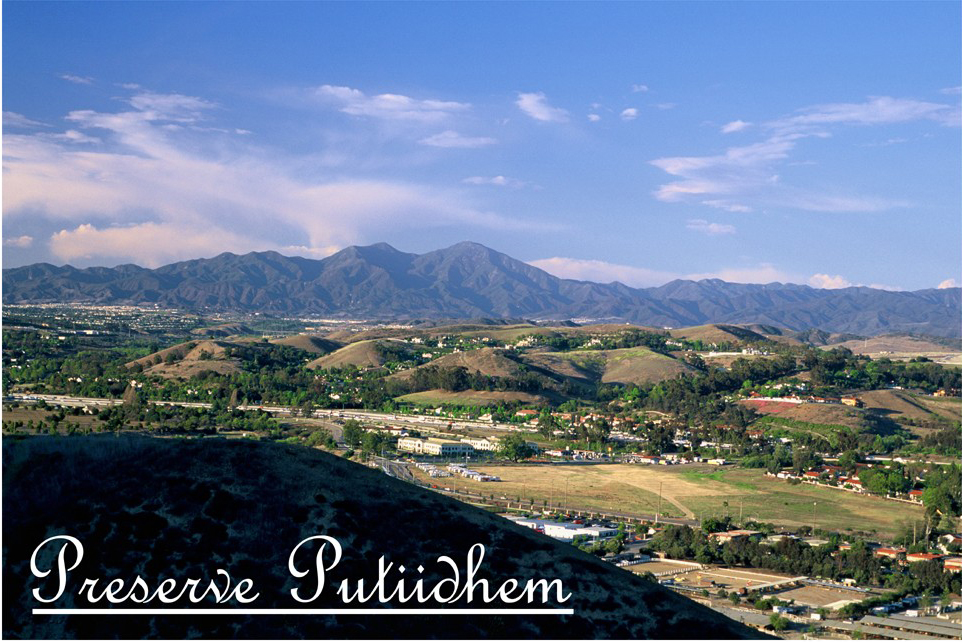

Putiidhem with Kalawapa (Wooded Place) in background Copyright - K. Stockwell
Putiidhem
Putiidhem is the mother village and ancestral cemetery of the Acjachemen/Juaneno men/Juaneno Indians. The village of Putiidhem is generally located north of the City of San Juan Capistrano, and dates from AD 1200 to 1776; people at Putiidhem were removed to the mission, although the village continued to be used for ceremonial and religious purposes—as it does up to the present day.
Archaeological data indicate that the village of Putiidhem was a thriving village for at least 600 years. Oral traditions regarding the founding of Putiidhem have been passed on from generation to generation, and are documented in early Spanish and ethnographic reports. According to oral tradition, Chief Oyaison founded the village because of the growing population and a scarcity of plant resources at his village of Sejat, located approximately 20 miles to the northeast. Once the new village was established, he left his eldest daughter, Coronne, to be chieftain and returned to Sejat. Apparently Coronne had a herniated navel and this inspired the name for the new settlement: Putiidhem means "her navel" in the Acjachemen language. Coronne was the village chieftain for 20 years, and was greatly revered. Through time, this village also grew too populated. People began moving out to surrounding areas and Putiidhem became the mother village for the region.
At the time of European contact, many of the families living at Putiidhem were inducted into Mission San Juan Capistrano and the Acjachemen were named Juaneno after the mission. The Acjachemen built the Mission and many of the other historic adobes that are cherished and protected by the City of San Juan Capistrano. The village of Putiidhem and the ancestors of today's Acjachemen families are listed in the Mission records. Today there are over 500 local Acjachemen/Juaneno descendants who can trace their ancestry directly to this village and cemetery.
ORA-855, the Central Village Site:
The remains of the central village and cemetery are situated within 29 acres of undeveloped land at the NW corner of Junipero Serra Road and the San Diego Freeway in San Juan Capistrano, California. It is registered as sacred site N-ORA-17 with the California Native American Heritage Commission. The archaeological designation is CA-ORA-855, and test excavations have determined that it is eligible for the California Register of Historical Resources. The National Register of Historic Places nomination process is in process.
A plan for development of the 29 acres containing the remaining portion of the central village of Putiidhem have been submitted and approved by the city of San Juan Capistrano. The approved plan will allow for the expansion of the Junipero Serra High (J Serra), a private Catholic high school, on the property. Some earth-moving activities have already occurred.
The plan to construct the Junipero Serra High School on the land has been described as a creative solution that meets various communities’ needs. But the destruction of this site will severely affect the cultural and spiritual well being of the Acjachemen Nation. The Acjachemen's needs to protect their ancestor's graves and to have access to the site so that they can pray and renew their ties with their history and culture have been largely ignored.
Associated Village Sites:
Archaeological studies have shown that the village of Putiidhem extends beyond the central village site. Multiple locations comprising the village of Putiidhem have been discovered over the years during archaeological surveys and studies, but (with the exception of the portion recorded as ORA-855, or the J Serra property) the village has never been systematically studied. Therefore, much of the cultural deposit associated with the village could remain intact; in fact, much of the site may be buried under alluvium and sediment on properties extending well beyond ORA-855.
Some of the land near ORA-855 was surveyed for cultural resources as part of a circulation study of the area and as an assessment of lands for inclusion in the city park system; numerous sites were found. There are many separate archaeological sites recorded as the village of Putiidhem. This has happened as part of the land development process; each time a proposed development or improvement project was proposed, a portion of Putiidhem was found and recorded under a separate site number. However, cultural resource surveys of the surrounding lands have resulted in the discovery of associated sites and at least one burial.
While these associated sites are not yet protected and could befall the same fate as ORA-855, an opportunity still exists to take action for their preservation.